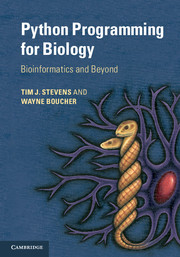Book contents
- Frontmatter
- Contents
- Preface
- Acknowledgements
- 1 Prologue
- 2 A beginners’ guide
- 3 Python basics
- 4 Program control and logic
- 5 Functions
- 6 Files
- 7 Object orientation
- 8 Object data modelling
- 9 Mathematics
- 10 Coding tips
- 11 Biological sequences
- 12 Pairwise sequence alignments
- 13 Multiple-sequence alignments
- 14 Sequence variation and evolution
- 15 Macromolecular structures
- 16 Array data
- 17 High-throughput sequence analyses
- 18 Images
- 19 Signal processing
- 20 Databases
- 21 Probability
- 22 Statistics
- 23 Clustering and discrimination
- 24 Machine learning
- 25 Hard problems
- 26 Graphical interfaces
- 27 Improving speed
- Appendices
- Glossary
- Index
- Plate section
18 - Images
Published online by Cambridge University Press: 05 February 2015
- Frontmatter
- Contents
- Preface
- Acknowledgements
- 1 Prologue
- 2 A beginners’ guide
- 3 Python basics
- 4 Program control and logic
- 5 Functions
- 6 Files
- 7 Object orientation
- 8 Object data modelling
- 9 Mathematics
- 10 Coding tips
- 11 Biological sequences
- 12 Pairwise sequence alignments
- 13 Multiple-sequence alignments
- 14 Sequence variation and evolution
- 15 Macromolecular structures
- 16 Array data
- 17 High-throughput sequence analyses
- 18 Images
- 19 Signal processing
- 20 Databases
- 21 Probability
- 22 Statistics
- 23 Clustering and discrimination
- 24 Machine learning
- 25 Hard problems
- 26 Graphical interfaces
- 27 Improving speed
- Appendices
- Glossary
- Index
- Plate section
Summary
Biological images
Often in biology and medicine the data people use comes in the form of an image. This could be as simple as a photograph of some cells or an image that has been constructed from other data, e.g. from an MRI scan. The images that we will be discussing in this chapter, whatever their source, will be pixmap images, also known as raster images. They will be constructed as rectangular arrays of colour or grey values, the smallest square element of which we refer to as a pixel. We will not be considering the vector graphics approach to making pictures, where the data is described in terms of lines and shape outlines. Here we will concentrate on pixel arrays, the kind of image data that comes from our digital cameras and various scientific instruments.
We will deal with pixmap images in a general, slightly mathematical way. It will not matter what the image actually represents for the most part, although we will endeavour to give examples with a biological flavour. Not so long ago images would largely be acquired by using photographic film, but now the digital camera is ubiquitous, and without the need to buy expensive film a scientist can capture as many images as time and storage capacity allow. Thus the examples presented here will often have an emphasis towards automation, and if you need to write programs dealing with biological data this will allow you to construct efficient analytical pipelines.
- Type
- Chapter
- Information
- Python Programming for BiologyBioinformatics and Beyond, pp. 361 - 381Publisher: Cambridge University PressPrint publication year: 2015



